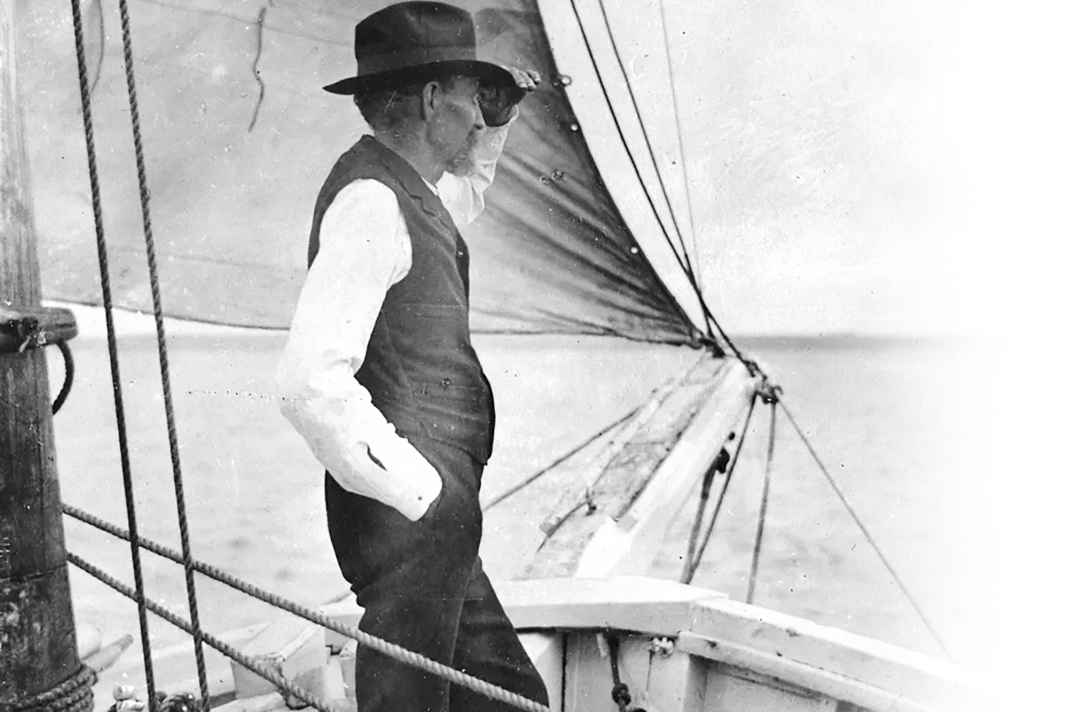





Joshua Slocum was 51 years old when he sailed around the world alone from Boston on 24 April 1895 with $1.50 in his pocket. His boat was a 36-foot oyster fisherman that he converted himself. His circumnavigation made him a legend, and his death is still shrouded in mystery to this day.
Joshua Slocum was born in Nova Scotia, Canada, in 1844, the fifth of eleven children. He developed a fascination for the sea at an early age that would stay with him for the rest of his life. At the age of 16, he left home for good and signed on to a timber freighter. In the following years, Slocum made a stellar career in merchant shipping and became second mate at the age of just 18. The 1860s and 1870s marked the high point of sailing shipping. During this time, Slocum sailed the Atlantic, the Caribbean, the Pacific and the South China Sea. In 1869, at the age of 25, he was given his first command of a coastal schooner. Shortly afterwards, he was already leading the barque "Washington" on a long voyage. In Australia, he met his first wife Virginia, who accompanied him on his sea voyages from then on.
Career peak and decline
Slocum's career reached its zenith in 1881. He took command of the clipper "Northern Light" and was even able to acquire a share in the fast ship. But the rise of steam shipping heralded the end of the sailing ship era. Slocum, who detested steamships as "dirty, smelly ships", had to witness the end of his world. A circumnavigation with the "Northern Light" becomes Slocum's last great trading voyage. It is characterised by adversity: Mutiny, a volcanic eruption and a severe storm in which parts of the cargo have to be thrown overboard. In 1884, Slocum's wife Virginia dies of heart failure while the ship is anchored off Buenos Aires.
Blows of fate and new beginnings
In the years that followed, Slocum suffered further setbacks. A second marriage failed and he lost his ship and cargo. In 1887, he finally ran aground in Brazil after his ship "Aquidneck" ran aground on a sandbank. In this hopeless situation, Slocum comes up with a bold plan: he builds a new boat to sail himself and his family back to the USA. The 35-foot "Libertade" took six months to build. With this self-built ship, Slocum actually manages the 5,510 nautical mile crossing to South Carolina. But back in the USA, he realises that the world has moved on. Steamships and railways have replaced sailing ships. Slocum is left with nothing - no wife, no home, no fortune and no job.
The first single-handed circumnavigation
Slocum's fate changed in 1892. A captain friend gave him a 100-year-old oyster cutter in need of a general overhaul. Slocum set to work and completely rebuilt the ship over the course of 13 months. He christened it the "Spray" and invested all his remaining money of 553.62 dollars in the project. On 24 April 1895, Slocum set sail on the "Spray" to become the first person to sail around the world alone. The greatest challenge was the passage of the dreaded Strait of Magellan, which took him two months. But Slocum overcomes all adversity. After three years and 46,000 nautical miles, he arrived back in Newport, Rhode Island on 27 June 1898, completing the first single-handed circumnavigation in history.
Literary success and mysterious disappearance
Slocum wrote about his experiences in the book "Sailing Alone Around the World", which was published in 1900 and became a bestseller. The school dropout not only had an impressive career as a captain, but also wrote a classic of sailing literature. The work continues to inspire countless sailors and adventurers to this day. But what is to follow this triumph? Slocum found no peace on land. In 1909, he set off on another voyage, this time with the aim of exploring the Orinoco and Amazon. It was to be his last voyage. The "Spray" disappears without a trace and Slocum is never seen again. He was officially declared dead in 1924.
Joshua Slocum's life was characterised by highs and lows, pioneering spirit and tragedy. His single-handed circumnavigation made him immortal, but his mysterious disappearance remains a mystery to this day. Was it a storm, a collision with a steamer or did the old sea dog find his long-awaited last adventure after all? The answer lies hidden somewhere on the vast ocean that Slocum loved so much.
Technical data of the "Spray":
- Length: 36 feet 9 inches (11.2 metres)
- Width: 14 feet 2 inches (4.3 metres)
- Draught: 4 feet 2 inches (1.27 metres)
- Displacement: approx. 9 tonnes
- Sail area: approx. 72 square metres
- Year of construction: ca. 1801
- Remodelling by Slocum: 1892-1894
- Reinforced bow for ice travel
- Self-steering system made of rope and wooden pegs
- Only timepiece: used tin watch for 1 dollar

